Stone Circle: OS Grid Reference – SE 12610 45062
Also Known as:
- Druidical Dial Circle
- Twelve Apostles of Ilkley Moor
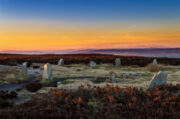
There are many ways of reaching the Apostles, but I’ll stick to describing the two commonest routes for those of you who wanna find it. The first is the route out of Ilkley. Get to the White Wells (white building nestled on t’ edge of t’ moors) – ask a local if you don’t know where it is. From here follow the path up past the Wells, up the stepped-cliffs, and once on top where there’s a crossing of paths, keep straight forward onto the moors for about a mile. Once you’re on the very top of the moors, keep your eyes peeled to the left of the footpath and you’ll see it! From the other, southern-side of the moor, start from Dick Hudson’s pub, cross the road and go up the footpath onto the moor. Now, just keep walking for a mile or so, until the circle appears on the right-hand side of the footpath right near the very top of the route.
The other route is easier if you’re unfit. Go up the old Roman Road which crosses the moors and when you get to the two radio masts on the top, take the footpath east. Walk straight on for about a mile until the path veers to the right (southeast). This is Ashlar Chair. From here, take the left-hand path and walk on for a few hundred yards till you hit the main footpath. Double-back on y’self (right) and the Apostles are about 100 yards away.
Archaeology & History
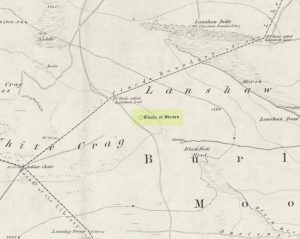
First highlighted on the 1851 Ordnance Survey map as a “Circle of Stones” close to “The Stone called Lanshaw Lad”, the Twelve Apostles stone circle is one of the highest of all ancient monuments upon Rombald’s Moor, 1264 feet above sea level. Only a small prehistoric enclosure (recently discovered) and the defamed giant cairn at the very top of the moors, known in previous centuries as ‘Nixon’s Station’—described in 1885 as being a hundred-and-seventy-five yards in circumference, then in 1900 as a hundred-and-fifty-yards—are higher. It is by no means a spectacular stone circle. Certainly in comparison to places like Castlerigg, Avebury, Callanish or the Argyll stones, it fades into insignificance!
In earlier times the circle possessed such names as the ‘Druid’s Chair’ and the ‘Druidical Dial Circle’—the first of which implying it to have been a place of ritual inauguration, and the latter a folk remnant of it being a site where the solar and lunar year would be recorded. Indeed, as early as 1850, antiquarian and rambler James Wardell described this site as “the astronomical circle,” after local folklore about the site being used as such. Today, such ‘folklore’ has entered into being academically acceptable in many quarters; though the significance of such alignments is still hotly debated.
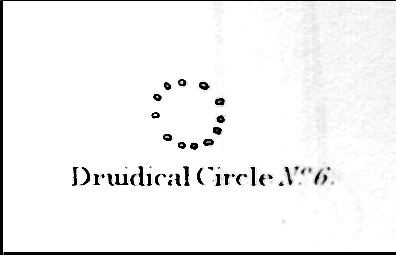
What greets us today would have been, several thousand years ago, planned and prepared sometime before the stones were erected close to the crossing of the two most important trackways crossing these moors, marking “an event of some importance.” These trackways face the four cardinal points, or airts, and one of them is believed by archaeologists to have been a major prehistoric trade-route that crossed the mid-Pennines. Around 1800 BC – the academics guess – the ring of stones took form.
The all-but-forgotten Black Beck Well (SE 1276 4494), two hundred yards south of the Twelve Apostles, was an important water-hole for our prehistoric traders and travellers and may well have had some function relative to this megalithic ring. Certainly, the well was being used by traders late into the 19th century.
According to archaeologist Arthur Raistrick, the Twelve Apostles originally consisted of at least twenty upright stones with a solitary monolith at its centre. It was this central stone which, not unsurprisingly, gave it the tradition of being a druidical dial circle. This is probably not without foundation as the centre-stone may well have acted as some sort of shadow-marker, or simply the point from where solar, lunar and perhaps stellar observations were made. When Raistrick first came here though, he reported that only three of the stones were standing. A few years later when Cowling described the site, he said that all of the stones “are now overthrown.” This is, sadly, something we have to constantly deal with. In Raistrick’s further description of the Apostles, he wrote:
“The circles of stones is erected on a bank of earth and small stones, as nearly circular as can be measured, and fifty-two feet (15.9m) in diameter, centre to centre of bank. The bank is about four feet wide and in places about two feet above the surrounding ground level.”
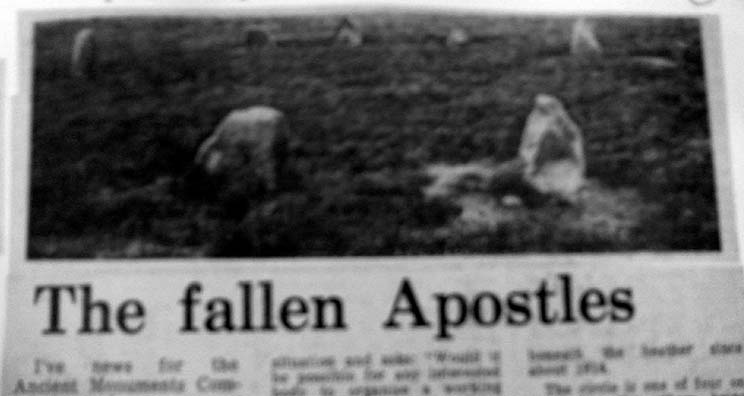
Cowling’s measurements told it to be fifty-eight feet across. Sadly, traces of the raised embankment that once enclosed the entire circle can now only be seen in the undergrowth on the south-side of the ring. When the heather is low you can make out an arc of raised rubble about 12 inches high and no more than a yard across, running for some 20 yards along the edge of the circle. In the 1960s all of the standing stones in this circle had been knocked over and were left ruinous in deep heather. The local authority council and regional archaeologist of Ilkley and district were (and still are) negligent of their duties to look after the ancient monument on these moors. Thankfully a group of local heathens took it upon themselves to stand the stones back upright and restore the circle to roughly how it looks today. Local pagans and amateurs have looked after the Apostles, restoring it when vandalized, from the ’70s onwards. In all honesty — and the same still applies to this day — if we’d have waited for the local archaeologists to get off their arses to restore the Twelve Apostles, it would have been destroyed long ago.
In more recent times, the site has been ascribed as “a circular ceremonial monument”, which I think is appropriate, although no burial or ritual remains have ever been found here. As we shall see however, this description is most fitting when put into context with the wider landscape.
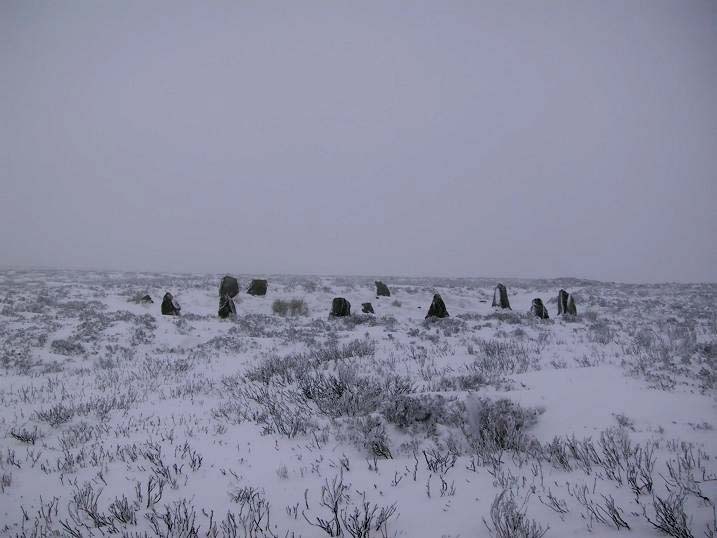
Visitors to the Twelve Apostles should be aware (if they weren’t already) that the circle they see today bears little resemblance to the place when it was first constructed around four thousand years ago. The scattered woodland which covered most of these now-barren moorland heights have long since gone and the stones have been moved and overthrown so many times that it would be very difficult indeed to gain an accurate picture of what the circle originally looked like. But this should not deter our investigations.
We should also be very cautious in making assumptions about the nature of pre-christian events that occurred here. Although modern pagans frequent this place at set times of the year, their activities have little, if any bearing, on the rites of our ancestors (despite what some of them might tell you!). However, scattered historical accounts do tell us about the activities of more obscure events hereabouts.
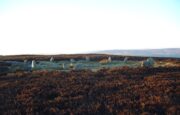
At the nearby Roms Law or Grubstones Circle (SE 1363 4473), records tell us how local people gathered on Rogation Day (a pre-christian agricultural ritual festivity, closely related to Beltane). A central stone—now moved into the huge Great Skirtful of Stones tomb a few hundred yards east—stood at its centre and an orator spoke to the people from here, ending with the words, “This is Rumbles Law!” Although we have no records of such actions at Twelve Apostles, the central stone which once stood here may have been a focus for such orations. The tribal leader and tribal shaman would have enacted this in ancient days. However, we do know from folklore records that the fabled Pendle witches and the lesser-known witches of Fewston (in the beautiful Washburn Valley a few miles to the north) met together on top of these hills, and the Twelve Apostles is a good contender as one of their likely assembly points.
Any verifiable history of Twelve Apostles is, as we can see, somewhat scarce, although in recent years observations from the site itself at select times of the year (solstices, equinoxes, etc.) have brought us a greater wealth of information.
As every good geomancer knows, literal knowledge about a place in the landscape is limited: how we look at such ritual sites determines, to a very great degree, how much we receive. If we look at the site as an astronomer, we will see the place through astroarchaeological eyes; if we look at it as an architect, mathematical formulae will overlay the complex; or if we see it as a New Ager, angels and auras will appear. With this in mind it is imperative we look at such places with a non-ethnocentric perspective. No easy thing.
Curious Alignments
Although dispossessed of its original spirit, it does not distract us from perceiving some elements of what appears to be one original function of the site. Its position in the landscape was obviously of grand geomantic importance and, having watched the motion of both sun and moon from this quiet ring of stones (the lunar standstills are recorded here), one is impressed, if not by its feeling, certainly by its siting relative to other arcane monuments. Those who know the Twelve Apostles and have visited it on a fine clear day will know what I mean. The view is considerable, peering far into the uplands of the Yorkshire Dales, looking upon a great panoramic circle nearly eighty miles across. I remember seeing this for the first time as a child and was entranced by it. So why had they placed this circle where they had…?
Looking at the Twelve Apostles on a large-scale Ordnance Survey map (6-inch to the mile, or 1:10,000)—as most linear-thinkers do nowadays—we see a remarkable geometric image unfold before our eyes. Running straight eastwards 1180 yards away (1.08km) we reach the Grubstones circle. From the Apostles again, go straight north for another 1180 yards (1.08km) and you reach the ruins of the Backstone Circle (SE 1261 4613). Between these three circles we find a perfect isosceles triangle. But this isn’t the end of it: the longer axis connecting Grubstones to Backstone is some nineteen-hundred yards long (1.731km) and at the mid-point along this line, the now-recumbent Lanshaw Lass boundary stone once stood. Intriguingly, if we stand at Twelve Apostles for the Beltane sunrise (May day), we would see its golden orb rising on the far-eastern horizon right above our Lanshaw Lass.
This all may, of course, be coincidental. Our megalithic ancestors surely knew nothing of isosceles triangles and such stuff…

Other astronomical alignments are perhaps not as contentious. In 1989 when the moon rose at its maximum northern point on the horizon (which occurs every 18.6 years and is known as the Major Lunar Standstill), it was photographed setting on the north-western horizon behind the old cairn which once stood just 130 yards away to the northwest, behind which stands the old boundary stone of Lanshaw Lad (this cairn was recently destroyed by some stupid halfwits from Ilkley). This alignment, if transposed onto a map and extended further, eventually reaches a quite remarkable ancient carving known as the Swastika Stone (SE 0956 4695) more than two miles away.
This alignment may again be coincidental as there are so many prehistoric sites upon these moors. Indeed, it seems that it would be hard not to find alignments up here! And although not all stone circles have astronomical systems encoded within them, studies show that many of them do.
The Summer Solstice Alignment
One very curious and probable alignment at the Apostles is the midsummer sunrise. It is celebrated every summer here by local folk who have been visiting the place, in recent years at least, for the last thirty years, despite the contorted attempts by the Church to suppress its natural celebration. In recent years the number of people visiting Twelve Apostles at midsummer has steadily increased; so much so that people are now scattering the moors in their hundreds to other sites. For many years I ambled my way up to this old ring of stones and waited for the sun to rise at summer solstice. After a few years the question of “Where exactly does it rise?” on this longest of days intrigued my teenage mind, but I had to wait a few more years until the morning air was clear enough to see the distant skyline…
Then, on the morning of the summer solstice in the mid-1980s, whilst the people around me were drumming, cheering, chanting and silencing themselves as the giant fireball rose once more from its daily horizon, I stood gazing, not at the sun, but at the very land beneath where it rose on that longest of days. And what I saw stunned me!
More than thirty-five miles (53km) northeast from the Twelve Apostles, the faint etching of a great white horse scarred the distant landscape exactly beneath where the sun rose on this longest of days. I must admit, I was metaphorically kicked in the neurological bollocks by this! If my eyesight wasn’t truly impaired by a night of no sleep, the far distant solar indicator I could see was the White Horse of Kilburn (SE 5142 8129)…
…And white horses, as is known in folklore, are potent symbols of the sun.
The real screwball with this sunrise indicator lies in the fact that Kilburn’s white horse was etched into the hillside only in the middle of the 19th century! It was cut into the slopes by a local man called Thomas Taylor. He had visited the magnificent prehistoric white horse at Uffington in Oxfordshire, plus others in the Vale of the White Horse, and was so impressed by them that he decided to make one in his own back yard, so to speak. After considerable effort and with the help of more than thirty local men, the steep slopes northwest of Kilburn had its own Epona: 314 feet long and 278 feet high. Said by one writer to be “visible for twenty miles” and another that it “could be seen up to seventy miles away”—figures that need drastically revising!
Despite the revelation that the midsummer sunrise from Twelve Apostles aligns with the White Horse of Kilburn, it was obvious that no arcane relationship—and hence no authentic mythic virtue—was possible here. The fact that some four thousand years separate the construction of both monuments precludes any valid connection between them.
This aside, I asked a research of friend, Graeme Chappell, to run through the possible astroarchaeology from Apostles to Kilburn in order to ascertain the validity, or otherwise, of this seemingly incredulous alignment. Lo and behold, in 1857 (when the Kilburn horse was completed), the “sun would have risen when it was over the white horse, but only just.” So I began putting this long distance alignment down to nothing more than a wonderful visual coincidence—until Graeme pointed out a much more curious astronomical folk remnant…
Around 1700 BCE, close to the time when Twelve Apostles was built, observers standing at the circle would watch the midsummer sunrise exactly over White Mare Crag. This wouldn’t seem that curious were it not for the folklore of these distant crags, themselves deeply symbolic of the sun.
The renowned Victorian antiquarian and folklorist, Edmund Bogg, wrote extensively about the curious legends that abound in and around the Kilburn area—several of which surround the great cliffs of the White Mare (locally known as Wisson Cliff in times past). Tradition tells that a white horse was once visible in the hillside here. Bogg told that it received its name from this horse, whose shape was visible in the shape of the huge rocky crags. At the bottom of the cliffs the faerie folk were said to live. Also here is Gormire Lake—bottomless according to folklore and apparently the abode of a sunken village, though history records (and geology) make this unlikely, so we must seek elsewhere for an explanation to such a tale. The waters of this lake fall into a small crevice at its edge and, so legend tells, these then flow uphill until eventually re-emerging at a well at Cold Kirkby village a mile to the east in the direction of the setting sun. These tales in themselves are intriguing relics of shamanism whose nature lies beyond the scope of this enquiry.
One folktale tells of a local ‘witch’ who was chased over the local moorland (by who or what isn’t remembered). She eventually reached the edge of White Mare Crag cliffs where she carried on running and jumped, landing in the waters of Gormire Lake beneath where it was thought she would drown. But, following the flow of water underground, the tale tells how she eventually re-appeared nine miles away out of an old (unnamed) well. An equally curious piece of lore tells of a goose that was dropped into the same crevice the witch went into after it had apparently dried-up, only to emerge, without any feathers, twelve miles away to the east at Kirkbymoorside.
But one tale in particular appears, to me at least, to have considerable relevance to our midsummer sunrise from the Twelve Apostles…
A long time ago an abbot from Rievaulx Abbey was in possession of a pure white horse, said to be as quick and nimble as any horse in the region. The abbot met up with a local landowner, Sir Harry Scriven, who also owned a horse of great repute – this time jet black, called Nightwind – and he challenged him to a race across Hambleton Moors (just above White Mare Crags). Sir Harry accepted, but the abbot insisted they swapped horses so that he could ride Nightwind and Harry was on the white steed. They took off, racing fast over the high moors until they reached the edge of White Mare Crags but, instead of stopping, the abbot continued galloping with Sir Harry following until they each plunged over the edge of the high cliffs. Legend tells that as Sir Harry fell to his inevitable death, the white horse which he rode dissolved into thin air and, as he looked across at his own horse Nightwind, looked at the abbot who turned into the devil. As Cooper points out, “the winged horse is the sun…as is also the white horse,” and as the horse in this legend “dissolved into thin air” as it went west over the Crags, could this be an old symbolic tale of the setting sun dissolving as it sets over the far horizon to the west? The black horse which remains, Nightwind: is this not the dark night which naturally follows?
We might never know, but it certainly makes sense of the tale. Especially when seen in relation to the summer solstice alignment from the Apostles. And if there was any possible commemoration of this line from White Mare Crags, the dark horse, Nightwind, would be the triumphant one, as the alignment into the far southwest from here to Twelve Apostles records the shortest night of the year: the winter solstice. Intriguing stuff!
But this primary midsummer alignment from Twelve Apostles gets even more curious…
Although books and magazine articles detailing ‘leys’ are numerous, they are, on the whole, full of lines that exist simply in the mind of their creators. Knowing these non-existent ‘old bent tracks’ — as us Yorkshire folk have come to call them! — are ammunition for trivialising the subject, precision is extremely important. It is obvious in this alignment however, that we are looking plain and simply at an astronomical line—not a ley. But, in good old fashioned ley-hunter style, I decided to get out the Ordnance Survey maps—2½-inch-to- the-mile scale—and check the cartographic nature of the line for myself. It took some doing! But its outcome threw up yet more bizarre finds, bending the parameters of Jungian synchronicity, never mind geodelic science!
As the illustration here shows, the line passes an old stone in the village of Askwith. A little further on we pass what Eric Cowling called ‘The Old Man of Snowden’—a squat standing stone close to the crossroads which appears to have been destroyed. Here too is the Grey Stone: an ancient boundary marker scared with intricate cup-and-ring designs. Although we pass one or two other fascinating spots where good folklore and history can be had—such as the moot points of Sword Point and Jack Hill—things don’t really start getting too interesting until we pass Nidd Church. (SE 3013 6081) “In the churchyard,” wrote Arthur Mee, “is the shaft of a cross about 600 years old, but it is said that the story of the village goes back twice as far, and that a great church council met over 1000 years ago.” This is more than likely, for just beyond is a place called Temple Yarmer where, as Harry Speight reminded us, once stood “an immense menhir or standing monolith.” Folklore told it to have been part of a now lost stone circle.
A little further on we pass by a few old boundary stones (SE 3160 6219; SE 3568 6578), but these will have nothing to do with our midsummer alignment. Not until we pass by the gigantic Devil’s Arrows at Boroughbridge (SE 3912 6650) do things begin getting a little bizarre. Although just three huge monoliths remains today, we know that least five of them were standing in the 15th century. It is very probable that more standing stones were in the original complex and our solar line may have crossed part of it. More certain are we of the midsummer’s day horse-festival that has been held here for many centuries. Known as the Barnaby Fair, recent years have seen the event almost vanish into history. But the motif of horses and midsummer here is intriguing. Nearby, at Kirkby Hill – over which our solar line crosses – is a spot known as the Fairy Hill and where, at midsummer, the little-people were wont to play in the early hours.
Continuing further and getting ever-closer to the White Horse which stands out from the Apostles, we reach the North Yorkshire village of Sessay. Here once lived a great one-eyed giant, said by folklore to be one helluva nasty dood – but this is just the Church demonising something it refused to try understanding. (In the neighbouring towns and villages of Topcliffe, Dalton and Pilmoor are other giant legends. It would be interesting to find the archaic roots of this geographical cluster.)
Next we reach the village of Kilburn itself. And here, every midsummer as far back as records can go, we have another horse festival. The activities here have truly heathen origins, comprising in parts to a great feast over the midsummer days. During this a procession itself is made by the villagers to the White Horse. We also have the figure of an androgynous ‘Lady Mayoress’ who runs through the streets receiving kisses from other ladies.
The final point on our journey along this midsummer line is the White Horse itself, whose visibility from Twelve Apostles started this journey in the first place.
The truly curious ingredients in this line is the coincidence (?) of midsummer fairs and horses as we travel along it. One wonders if there’s some sort of Cosmic Joker sat behind it all, rubbing its hands gleefully, waiting for the crazy speculators or New-Age dreamers to proclaim a Divine Rule or something similar. Stranger things have happened…
…Like the midwinter alignment from Twelve Apostles…
From our humble stone circle we trek out, south-east this time, first passing the Black Beck Well [SE 1276 4495] and then an ancient boundary stone [SE 1357 4430], before reaching Odda’s Hill. Slightly past here and below Hawksworth Hall is the Alder’s Well [SE 1671 4168] where a ceremonial procession used to be performed starting at the Hall—but I have been unable to establish what time of year this occurred. But, just a little further on, our midwinter line comes to the Hawk Stone [SE 1792 4099] where, “legend tells that a man on horseback leapt from the top of the Hawk Stone and landed safely at Low Hall, Yeadon, 2500 yards east.”
A man on horseback, jumping over cliffs on a midwinter solstice line… Doesn’t that ring a bell somewhere…? What’s the hell’s going on here…?
There is a modern piece of folklore about the Apostles which has been written purely to see if others should simply repeat it without ascertaining its veracity. We find it in Andy Roberts’ book (1992) and the folklore and legends of Yorkshire. But his tale for the Twelve Apostles is without foundation. He wrote how,
“legend says it is impossible to count the stones correctly at the first attempt.” Adding, “From here the Wild Hunt, dead souls led by the devil, were said to fly out across the moortops in search of victims, and fairies have also been witnessed” here.
None of this is true! Andy told me he’d deliberately invented a few tales in his book for the fun of it — and that bit is one such invention!
Strange Lights
If our flying horses and solstice sunrises verge on the borderline of possibility, to many people the same cannot be said of the strange lights which have, from time to time, been seen around Twelve Apostles. Reports of ‘UFOs’ as they are generally known, should more accurately be described as ‘earthlights,’ or ELs. These are consciousness-sensitive light-forms which are known to interact with humans who come into close contact with them. The modern myth of them as spaceships is the latest in a long line of historic perspectives. In earlier times, people who saw these ELs transposed the thought of airships onto them. Before that, people saw the huge glowing eyes of phantom dogs and other entities emerge from them. Earlier still they were known as faerie-lights. Around the same periods they were devil-lights or witches on broomsticks. Some people saw them as gods, to which the lights accordingly responded. Religious folk have watched Jesus, the Virgin and angels emerge from these lights when they’ve got too close. But it must also be said that a great number of people who see such ELs see nothing but that: anomalous light-forms floating or darting about curiously, seemingly with a mind of their own.
One of these ELs certainly perplexed three members of the Royal Observer Corps in the summer of 1976 during exercises on the moors. Heading towards the Twelve Apostles they suddenly noticed a brilliant white sphere of light, seemingly hovering right above the stone circle at a low level. It made no manoeuvres other than, eventually, shooting straight upwards into the sky at remarkable speed and out of sight, without making a sound!
In July 1990, two witnesses who spent the night at the Backstone circle (a site with a considerable pedigree of supernatural events) watched another brilliant white ball of light about a mile away, low down on the horizon, move quickly and silently from the west until reaching Twelve Apostles, where it stood motionless for some time. It then backtracked rapidly at tremendous speed, before returning to the circle, executing a 180° turn without stopping or slowing down. It then flew back west and rapidly out of sight. Within seconds of this, the witnesses allege a military jet flew right over the moors following the trajectory of the object.
On a couple of occasions I’ve seen what geologists call ‘earthquake lights’ emerge from the ground immediately around Twelve Apostles at the dead of night, lighting the sky up for a considerable distance around the circle.
And that imaginative writer Nicholas Size (1934) reportedly watched the ghostly vision of a grand ritual procession from here.
References:
- Bennett, Paul, ‘Stone Circles of West Yorkshire,’ Earth 1, 1986.
- Bennett, Paul, ‘The Megalithic Faults of Rombald’s Moor and District,’ Earth 14, 1989.
- Bennett, Paul, The Old Stones of Elmet, Capall Bann: Milverton 2001.
- Bennett, Paul, The Twelve Apostles Stone Circle, TNA Publications 2017.
- Bogg, Edmund, Richmondshire and the Vale of Mowbray, James Miles: Leeds 1906.
- Burl, Aubrey, The Stone Circles of Britain, Ireland and Brittany, Yale University Press 2000.
- Collyer, Robert & Turner, J. Horsfall, Ilkley: Ancient and Modern, William Walker: Otley 1885.
- Cowling, Eric T., Rombald’s Way: A Prehistory of Mid-Wharfedale, William Walker: Otley 1946.
- Devereux, Paul, Places of Power, Blandford: London 1990.
- Devereux, Paul, Shamanism and the Mystery Lines, Quantum: London 1992.
- Hedges, John (ed.), The Carved Rocks of Rombald’s Moor, WYMCC: Wakefield 1986.
- Keighley, J.J., ‘The Prehistoric Period,’ in Faull & Moorhouse’s West Yorkshire: An Archaeological Guide to AD 1500, WYMCC: Wakefield 1981.
- Pennick, Nigel & Devereux, Paul, Lines on the Landscape: Leys and other Linear Enigmas, Hale: London 1989.
- Raistrick, Arthur, ‘The Bronze Age in West Yorkshire,’ in YAJ 1929.
- Roberts, Andy, Ghosts and Legends of Yorkshire, Jarrold: Sheffield 1992.
- Size, Nicholas, The Haunted Moor, William Walker: Otley 1936.
- Speight, Harry, Nidderdale and the Garden of the Nidd, Elliott Stock: London 1894.
- Speight, Harry, Upper Wharfedale, Elliott Stock: London 1900.
- Walsh, Roger, The Spirit of Shamanism, London 1989.
- Wardell, John, Historical Notes on Ilkley, Rumbald’s Moor, Baildon Common, etc., Leeds 1869.
Links:
- Twelve Apostles on The Megalithic Portal
© Paul Bennett, The Northern Antiquarian
Hi there –
I like your new website. About time more things like this was put on-line!
Just wondered what anyone thought of the recent opinions that some people have been writing, about not having fires at our stone circles? I was up at 12 Apostles this solstice and a group of us had a fire in the circle, as local people have done for many decades. I remember hearing that people met here and had fires in Victorian times, but nowadays people are saying we can’t do this anymore. Do you think our old traditions are going to be eroded by these people who know so little about it? It would be good to hear what other people think about this issue.
Cheers – Nidge
Me again!
If you go up this summer to the twelve apostles, look at the place where the sunrises at summer solstice, and yes notice the horse beneath, why not hang around and wait for the sun to set, and then ask your friend what constellation is rising above the same horse at sunset?
Don’t forget, ancient sky watchers were more interested in the sky at NIGHT because that’s when they could see constellations rising after sunset, when they weren’t put to shade by the sun.
read my blog
learnastrometerology.wordpress.com to discover a use for much of these stones on the moors, or
visit http://www.starsite.org.uk to read longer article about ancient recordings for the purpose of forecasting weather.
I know that my cartography skills are not the most reliable but aren’t the Twelve Apostles on Burley Moor and not Ilkey Moor?
Either my map is wrong or the academic texts have got it wrong.I think It’s about time Burley got the recognition for it’s famous stone circle.
Thankyou very muchly.
Thanks Paul Bennett. I’ve been hammering on for years about the exact location of this circle and still folk can’t get it right. Just sent an email to Friends of Ilkley Moor on the very subject. I knew some of the ‘pagans as you put it’ who put the stones up. Few know however of the stone labrynth a few hundred feet to the south of the circle. We found it thirty odd years ago. It may well be overgrown by now.
The labyrinth still remains, though is much overgrown, as you’d expect (you can see it clearly on GoogleEarth). That was laid by some pagans in the 1970s because of….. I’ll keep that quiet for the time. Another such labyrinth was laid closer to Ilkley, off the main path, but only its edges remain.